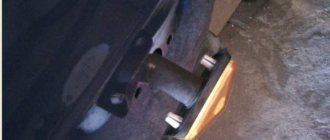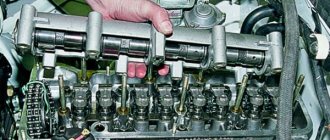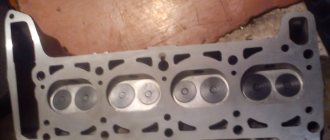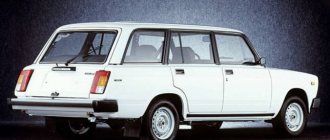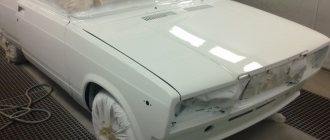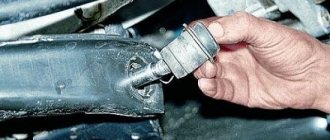| Comparison of dimensions, mm | Lada 2105 | Lada 2107 |
| Modification | 1st generation, 10.1979 — 01.2012, 1.5 l., 71 hp., Gasoline, manual transmission, Rear-wheel drive select another | 1st generation, 03.1982 - 04.2012, 1.5 l., 68 hp., Gasoline, manual transmission, Rear-wheel drive select another |
| Photo | ||
| Country of assembly | Russia | Russia |
| Secondary market price | ~50,000q | ~ 45,000 q |
| Fuel type | Gasoline AI-92 | Gasoline AI-92 |
| Body type | Sedan | Sedan |
| Transmission type | Manual transmission 5 | Manual transmission 5 |
| type of drive | Rear (FR) | Rear (FR) |
| — | — | |
| Engine capacity, cc | 1452 | 1452 |
| Power | 71 hp | 68 hp |
| Maximum torque, N*m (kg*m) at rpm. | 112 (11) / 3500 | 104 (11) / 3500 |
| Fuel tank volume, l | 39 | 39 |
| Number of doors | 4 | 4 |
| Trunk volume, l | 379 | 379 |
| Acceleration time 0-100 km/h, s | 17 | 17 |
| Weight, kg | 976 | 1060 |
| Body length | 4145 | 4145 |
| Body height | 1446 | 1446 |
| Wheelbase, mm | 2424 | 2424 |
| Ground clearance (ride height), mm | 170 | 170 |
| Fuel consumption, l/100 km | 8.8 | 8.5 |
| Rear wheels | 175/70 R13 | 175/70 R13 |
| Number of places | 5 seats | 5 seats |
| Owner reviews | Lada 2105, 1st generation, 10.1979 - 01.2012 VERY cheap to service, can be repaired on the highway. Lack of dynamics, lack of comfort, low quality of spare parts During the 8 years of use it was changed: rear axle gearbox twice, axle shaft assembly, shock absorbers twice, ball joints and silent blocks 3 times, crosspiece, gearbox repair. That's all, except for consumables, the engine has not been repaired and to this day the mileage is more than 230 thousand km. The car has been used by its brother for more than 5 years Warm interior Chassis Passable Comfort | Lada 2107, 1st generation, 03.1982 - 04.2012 Although the “tank” is not for women, I’m already used to it. When I sat down with her for the first time (she neighed like a horse), I don’t know why...probably because she was tossed in all directions. I live in a rural area not far from the city, so I have to drive over bumps, around the city, and on the highway. There are no problems driving around the collective farm, because... The suspension is soft, in the city it hasn’t gone anywhere yet, but on the highway it’s amazing! It throws its ass in all directions, holds the road poorly, and has difficulty taking turns. But really, I’m not afraid that it will break and I’ll get into money or lose money (because of the relaxed handbrake, I kissed the fence =) I don’t know about other drivers, but after driving a “bucket” my back hurts terribly = (the lighting in the low beam is bad, I constantly have to peer at the road, almost into a hickey with the windshield. The turn signals always fail at the wrong time. There was no protection, so when I was driving along the highway in the pouring rain in extreme conditions, water poured straight into my face through the steering wheel and from under the gearbox almost…..well…well, it’s okay, the car is still fire, I can’t even dream of anything better, and I drive I’ve been using it professionally for 2 years already (not like chickens on automatic machines). Sorry to anyone I offended =)))))))))))))))) this fucking 4-mortar, I suffered! From third I changed it to 5 and (fire!) I changed: starter, retractors, chocolate bar, pendulum, anchor, fuel pump, brushes, oil, float, steering wheel (the old one broke while driving, I drove home using the key - this you should have seen it!), brake pads, the generator was rebuilt twice, but the engine runs like a clock, doesn’t consume oil. The brakes are of course lousy, you have to brake almost a kilometer away. Durable, the engine always starts in a jiffy Cheap to maintain Fuel consumption, brick aerodynamics. Quality of spare parts Cheap spare parts Breaks often |
What is the difference between VAZ 2105 and VAZ 2107
And today there are many motorists who want to purchase an unpretentious and inexpensive, but at the same time reliable VAZ car. For older people, this is nostalgia, as well as a convenient option for personal transport for everyday trips: to the store, to the country. For young people without pathos or demands, this is the first personal car to get to school or ride with friends.
When purchasing, motorists rarely pay attention to the differences between models 2107 and 2105, because now they are not fundamental. However, at the beginning of the release the difference was significant. The “Seven” was produced until 1988 as a luxury car, and the “Five” in the same line was the standard. Later, model 2107 was also made standard and simplified.
The 2107 sedan, produced until 1988, was equipped with the best optional systems for those times: headlight washers, handbrake warning lamp relay, contactless transistor ignition, diagnostic block, brake pad wear sensors, oil pressure and crankshaft position.
Appearance
Both cars lack the streamlining characteristic of the design of modern models. VAZ is what is called a “brick on wheels” - a straightforward, angular, primitive car from a design point of view. This is the design that was popular in the automotive industry in the 1980s.
When producing the VAZ 2107 sedan, the model’s creators showed a little more creativity: as a result, the car turned out to be more stylish and interesting than its “relative” 2105.
The VAZ 2107 is equipped with a radiator grille protruding above the hood with an imitation chrome coating. Visually, it resembles the radiator used in older Mercedes models. Model 2105 has no hint of sophistication: the radiator grille is primitive, made of black plastic. But this is its advantage: the chrome imitation is actually unstable and comes off after a short period of time when the car is washed regularly.
The differences between the 2105 and 2107 car include several more exterior features:
- The “five” has a relief in the form of stripes stamped on the surface of the trunk, giving the car a more attractive appearance. But the hood, on the contrary, on the “seven” is decorated with raised stripes, while on the 5th model it is flattened.
- The headlights built into the 2107 sedan are equipped with an improved version of reflective elements, so the outgoing light is better than that of the 2105 model. The rear headlights differ in the shape of the light supply: in the VAZ 2107 it is rectangular, in the 2105 model it is square.
- Sedan bumpers differ in the material from which they are made. For the 7th sedan model it is steel, for the 5th it is aluminum.
Salon
The difference between cars 2107 and 2105 in terms of interior design and equipment is the most significant of all the characteristics under consideration. The seats of the first VAZ car are more comfortable because they have an anatomical shape and are equipped with a headrest. The interior design of the “Seven” is noticeably richer and more interesting: the doors and ceiling are upholstered with better quality, the rear pillars are decorated with plastic overlays.
VAZ 2105 and 2107 differ in their heating system. In the 7th model, the air flow passes through the head air duct located in the engine compartment. In the 5th model, air is discharged through the radiator. The VAZ 2107 is also equipped with a ventilation element - a cold air deflector.
Initially, the control panel of the 2107 car was significantly different from the one that the “five” was equipped with. An updated, more advanced steering wheel, radio unit and gearshift lever were used. Later, the 2105 cars began to be equipped with the same elements. The “Sevens” retained the clock left over from the 2106 model on the panel, but the “Five” is deprived of this element.
Driving in a 7 was more fun back in the day. This version of the VAZ had an outlet for installing a radio. But in the 5th version of the sedan there was only a “nest”, and its location was not the best.
Specifications
The technical parameters of the cars differ insignificantly. Both VAZ sedans are 4-door, 5-seater, rear-wheel drive.
| 2105 | 2107 | |
| length, cm | 414,5 | 414,5 |
| height, cm | 144,6 | 144,6 |
| wheelbase, cm | 242,4 | 242,4 |
| trunk capacity, l | 380 | 380 |
| ground clearance, cm | 17 | 17 |
| Weight, kg | 976 | 1060 |
| acceleration to 100 km/h, seconds | 18 | 16 |
| transmission | Manual transmission 5 | Manual transmission 5 |
| fuel combustion, l per 100 km | 8,8 | 8,6 |
Engine
Different engines were installed on the VAZ 2105 sedan, so it is impossible to determine the difference by this functional element of the car. Initially, the “five” was equipped with an engine from the VAZ 2101 and 2103, then cars with an improved 2105 engine began to appear. It was designed on the basis of the 2101 model, but differed in several nuances:
- timing mechanism drive with a belt instead of a chain;
- cylinder head with cast aluminum cover;
- protective recesses for valves.
As a result of the transformations, the engine of the VAZ 2105 sedan, like the 2107 car, became quieter and its service life increased.
Let's look at the key features of both VAZ engines.
| 2105 | 2107 | |
| volume, cm3 | 1452 | 1452 |
| power, hp | 71 | 68 |
| torque, N×m at 3500 rpm | 112 | 104 |
Injection system
At first, both sedan models were produced with carburetors. Later, injectors appeared. However, the carburetor “seven” was stronger than the “five”: it had not 68, but 77 hp. Also on the 7th VAZ car, the piston stroke increased and the cylinder diameter became larger. Proportionally this is from 67x69 to the value 80x76.
Both VAZ models have changed several series of engines in terms of volume. “Seven” at different periods was equipped with engines from 1.3 to 1.7 liters. The “five” had engines from 1.2 to 1.6 liters. There was even a rare version of the VAZ 2105 with an engine size of 1.45 liters. The updated injection “seven” was equipped with 1.6 liter engines.
The fuel pump in new models has become electric. The operation of most sedan systems is controlled by an electrical unit. Fuel consumption has decreased, the car has become less roaring.
Carburetor
Initially, the VAZ plant used Italian Weber. It was installed in models 2101 and 2103. Then carburetors were created specifically for “fives” and “sevens”. They were called “Ozone”; in the release catalog they were listed as 2105-1107010 and 2107-1107010. Later they created 4 improved versions of these carburetors; in the catalog they were designated with additional numbers at the end of the number.
The carburetors used in the VAZ 2105 differ from the settings of the 2107 sedan:
- diffuser diameter;
- automatic air damper drive;
- cross-section of the fuel and air nozzle;
- built-in economizer;
- presence of a fitting for a vacuum corrector.
When a new VAZ product, the 2108 car, entered the market, the Ozone carburetor was supplanted by a new, improved device called Solex. In the catalog it was designated as 21073-1107010. Improvements include a 3-piece design, a simplified economizer, and a fitting that returns excess fuel back.
Volume of the tank
Both VAZ models have a fuel tank capacity of 39 liters. Plus a reserve volume of 4-6 liters. The tank of VAZ cars is a galvanized steel container consisting of 2 connected plates. The outer surface is painted black.
On the described rear-wheel drive VAZ cars, the tank is located in the luggage compartment on the right, when looking in the direction of travel. It stands on a rubber base and is bolted to the body. The “throat” for filling fuel, sealed with a threaded plug, goes to the right rear panel of the housing. From the outside, the filling hole is covered by a metal lid, which opens when you press on it from one edge.
The fuel tank of VAZ cars is equipped with a ventilation system. Air enters its interior through a hose coming from the filler neck hole. When a car is driven over rough roads, fuel enters the hose and becomes a liquid blockage, preventing the hydrocarbon contents from evaporating.
On top of the tank there is a rheostat sensor for determining the amount of fuel and a fuel intake. The second device is connected to the fuel pipe on top, and a mesh for filtering fuel is attached to the bottom. The rheostat sensor is connected to the fuel level gauge on the dashboard. When the tank contents decrease to the reserve level, the contact elements of the warning light close and turn on on the instrument panel, indicating low fuel content.
At the bottom of the VAZ fuel tank there is a fuel drain plug. To open it, you need to remove the cover in the floor of the car.
Other characteristics
Let's look at how else VAZ 05 and 07 cars differ:
- For the “seven” the speedometer scale reaches 180 km/h. The “five” has a speed of up to 160 km/h. In reality, the 7th model is unlikely to be able to squeeze out more than 160 km/h. And the maximum real speed of the 5th sedan model is 150 km/h.
- It is more convenient to steer the “seven”, since its control wheel has a matte finish. But the steering wheel of the “five” is sliding, so it’s unlikely to be possible without a rough cover.
- Cars 2105 and 2107 also differ in cost, but only slightly. In recent years, when the 5th VAZ sedan came out of the assembly line, it cost an average of 175,000 rubles, and the 7th VAZ car cost up to 200,000 rubles.
Appearance
The exterior of the cars is practically the same, only a closer look reveals some differences. The 2107 radiator grille is made of plastic with a special chrome-plating coating; the 2107 has a nondescript version made of non-shiny black plastic. From a practical point of view, a “chrome” grille will be more susceptible to wear and corrosion, and with each washing process the coating will oxidize and then fall out.
VAZ 2105
The trunk lid of the 2107 looks more solid, thanks to the stamped relief, while the 2105 has a completely flat shape. The hood of the car also has minor differences in external similarity; in 2107 it has several additional bulges.
VAZ 2107
The head optics of the 7th model Zhiguli are equipped with a reflective element, which has both a visual difference from the 5th model and a brighter and more directional luminous flux. The 2107's taillights have a square rear light zone, while the 2105's are rectangular. The bumpers of the seventh model are made of carbon steel, while those of the five are aluminum.
The hood and trunk lids of VAZ models differ in the form of stamping. In the “seventh” model of the Lada, the hood lid has a higher relief than the hood of the VAZ 2105. And the trunk lid, on the contrary, in the seventh model has a flat surface, and on the “five” the lid is a stamped part with recesses.
Lada bumpers are made of different alloys. The “five” has both bumpers made of aluminum, while the VAZ 2107 has two bumpers made of carbon steel.
Is there anything in common between the “five” and the “seven”?
There are common features, and there are quite a lot of them. We can say that the VAZ 2105 and 2107 sedans are “twins” with some differences. It should be noted with regret that the characteristics that unite these models are, for the most part, far from modern standards. Here's how the cars are similar:
- Both cars “consume” AI-92 gasoline.
- Their carrying capacity is 400-450 kg.
- Stamped wheels 175/70 R13 are installed.
- The gearbox was initially installed as a 4-speed. Later, cars 05 and 07 began to be equipped with 5-speed units.
- Both models have weak hydraulic drive. The rear brakes remained drum brakes, the front ones also did not change since the beginning of production of the VAZ 2101. Rear-wheel drive does not ensure safe movement in mud puddles and icy surfaces. The braking distance is long.
- The steering system is outdated, worm-type. Moreover, it became outdated even in the first years of production of both VAZ models. Steering accuracy is poor. The wheel turns hard. During the journey, the driver is under constant tension in order to carefully maneuver on the road. A significant disadvantage of both cars is the steering system without amplifiers.
- The steering wheel itself is heavy and large. With such a diameter of the steering wheel, it is difficult for a motorist with a large body weight to sit in the seat.
- The suspension is also outdated and lacks the required degree of stability. Because of this, cars wobble when driving fast on the highway and roll heavily when turning. For this reason, sharp turns must be negotiated with extreme caution.
- The pedals are located non-standardly when compared to modern cars. They are tall and also located at a fairly large distance from each other. As a result, the driver is forced to sit with his legs wide apart. For motorists who have been driving a VAZ for a long time, this feature is not a problem; they are accustomed to this arrangement of legs. But if a person who has previously driven only modern foreign-made cars gets behind the wheel, he will initially experience discomfort.
- The windshield wipers of the VAZ 2105 and 2107 are poorly designed and cover a small surface of the glass. As a result, in rainy and snowy weather, the upper part of the windshield remains dirty, preventing a full view of the surrounding area.
- Both VAZ cars have small side mirrors, which makes normal visibility impossible. Although replacing the mirrors is not difficult, this will be done at any car service center.
- The internal plastic elements of VAZ 2105 and 2107 cars, especially those produced in recent years, squeak unpleasantly when driving on uneven roads. This feature is due to the low quality of the material used for the production of internal parts, including the dashboard.
- Both sedans are terribly noisy, making annoying sounds in every way. A motorist not accustomed to such cacophony may get a headache during a long trip. Everything that can make noise makes noise: engine, transmission, seals, aerodynamics. Therefore, many VAZ car owners are forced to pay money for high-quality sound insulation.
Engine
This is an important part of any car. But due to the peculiarities of AvtoVAZ’s production policy, this is not a detail by which one can understand how the VAZ-2105 differs from the VAZ-2107.
On the VAZ-2105, in addition to engines 2101 and 2103, a model with the index 2105 was installed. It was created by making several changes to the design of 21011:
- Timing belt drive instead of chain drive.
- Cast aluminum cylinder head cover.
- Recesses for valves to prevent damage if the belt breaks.
These measures have led to a significant reduction in noise from engine operation and an increase in service life.
The VAZ-2107 was equipped with the following engines: 2103, 2105 and 2106 with a volume of 1500, 1300 and 1600 cm 3, respectively. There were also modifications for the needs of the traffic police, the Ministry of Internal Affairs and the KGB. They used a VAZ-4132 rotary piston engine with a volume of 1.6 liters and a power of 140 hp. With.
Which one to choose?
When choosing a VAZ model, focus on your personal needs. The difference in price on the secondary market is insignificant, but the “seven” is somewhat more comfortable than the “five,” especially with regard to the seats, steering wheel and dashboard. And externally, the “seven” looks more stylish and modern.
It follows from this that the 2107 sedan is a car for long journeys. For example, you can use it to go out of town on vacation, to a dacha, or to a neighboring town. And the VAZ 2105 is a car for covering short distances within the boundaries of your hometown. For example, you can use it to go to the store or visit.
The VAZ 2105 sedan is optimal for pensioners, housewives, and students - these categories of drivers do not need to travel far, which means that overpaying for a comfortable ride is irrelevant for them. The VAZ 2107 is suitable for family people, as well as those who are constantly traveling for work or personal reasons. If your job involves regular business trips, then it makes no sense to buy an expensive modern car if you can buy a VAZ much cheaper, which you don’t mind using for work purposes.
Both cars, thanks to a 5-speed gearbox, develop good speed on the highway and consume fuel economically. Therefore, many taxi drivers in provincial cities choose these VAZ models for work. And cars of the 2105 and 2107 series are convenient for various tuning options. These sedans, despite their obsolete appearance, are often used for street racing, that is, street racing, and various competitions at the amateur level, for example, drifting.
Injection system
VAZ 2107 cars have recently been produced with an injection engine with a power of 73 and 77 l/s, with a displacement of 1.6 liters. The injection version has an electrically driven fuel pump and a main electronic engine control unit, which is responsible for the operation of many vehicle systems. Fuel consumption has decreased significantly compared to the carburetor version.
Both car models are equipped with a manual transmission system, with four or five gears, depending on the modification. They have a single-disc clutch type and rear-wheel drive with a cardan drive. The brake system of 2105 and 2107 is identical, the rear wheel brakes are drum type, the front wheels are disc brakes. Both cars are equipped with standard 13-inch wheels.
Quick comparison table
Despite the many years that have passed since the start of production, both sedan models remain in demand among Russian consumers. You can often find both cars on the secondary market. And to make it easier for potential buyers to make a choice, we will briefly list once again how the VAZ 05 sedan differs from the VAZ 07 model.
| 2105 | 2107 | |
| model | simple, standard | improved, used to be luxury |
| radiator screen | regular plastic | imitation chrome coating |
| relief decoration | on the trunk | on the hood |
| headlights | ordinary | improved |
| bumper | aluminum | steel |
| seats | ordinary | anatomical |
| heating system | through the head duct | through the radiator |
| fuel consumption | more | less |
| acceleration to 100 km/h | faster | a little slower |
| maximum speed | less | more |
| ease of control | low | a bit better |
| price | low on the secondary market | a bit higher |
Wheel rim parameters for model 2108
Like the 2107, the 2108 featured 13-inch forgings from the manufacturer. On the Lada Nine (VAZ 2109) with five doors, R13 wheel products were also used.
Tire parameters: 165/70/R13, 175/70/R13.
However, unlike the seven, the eight used discs with the following parameters:
- width 5J;
- departure ET40;
- drilling 4×98;
- diameter of the central hole is 58.6 mm.
Also, depending on the modification, wheels with sets of tires could be used on the eight and nine:
Let's sum it up
Those who have had a driver's license for a long time know about the differences between the VAZ 2107 and 2105. But beginners often have doubts about the choice, since distinguishing one car from another is problematic. And there is no particular difference in technical and functional equipment. The main differences relate to the external features of the “seven” and its comfort in terms of landing and control.
The VAZ manufacturer itself at one time considered the differences between the standard and luxury models significant. But now they have almost leveled out, both models are sold as budget ones.
VAZ 07 and 05 sedans are among the cheapest cars on the Russian secondary market, but potential buyers should understand that most of these models are many years old. This means that the quality of assembly and functional elements does not meet modern standards; many parts are worn out and require replacement. No matter which of the presented cars you choose, you cannot hope for a 100% safe and comfortable ride.
If desired, you can do tuning and update the car outside and inside. But this will require additional cash injections, and considerable ones. In this case, a more acceptable option is to purchase a modern car in the appropriate price category.
Interior
The interior of the car generally follows the contours of the body - it is just as angular, which gives it a progressive look in comparison with the smooth lines of the VAZ-2101 and 2103. There are few differences, as in the appearance:
1. Instrument panel.
The instrument panel in the Lada 2107 is distinguished by a convenient location for the radio and additional instruments. They include a digital clock, indicator lamps (brake pad wear, heated rear window, whether the driver is wearing a seat belt), and a cigarette lighter.
The switches located around the instrument cluster in 2105 are located in front of the gearshift lever in 2107.
2. Instrument cluster.
The instrument cluster in the “five” provides the driver with only basic information about the current state of the car: speed, coolant temperature, amount of fuel, voltage in the on-board network, total mileage.
The instrument cluster in the “seven” is additionally equipped with an econometer, a tachometer and a daily mileage counter.
3. Seats.
In the fifth Lada model, seats from 2103 were installed with a slight modification - they were equipped with a headrest. The seventh model was equipped with anatomical seats.
In motorsport
VAZ 2107M, a model intended as a replacement on the assembly line for the VAZ-2107 VAZ 2107M rear view
- This car is very popular in Hungary, where it has long become a cult car, and is widely used in motorsport (mainly in rallies);
- 2006—2010. Russian Classic Rally Championship - Grigory Novichikhin;
- 2010—2011. Russian Circuit Racing Championship (RTCC) - No. 77 Vladislav Kubasov, Team: VPK SPORT;
- 2012. BATTLE ROBOT CAR competition in Astrakhan, in which the VAZ-2107 was equipped with a remote control.
- Rally Bohemia 2012 in the Czech Republic
- New version of the traffic police
History of creation [edit | edit code]
The VAZ-2107 is a modified luxury version of the VAZ-2105, which, in turn, traces its origins to the Fiat 124, a subcompact family sedan from 1966 (winner of the 1967 European Car of the Year). The VAZ-2107 was exported under the names Lada Nova, Lada Riva, Lada Signet, Lada 1500
. [3]
From 2002 to 2012, the VAZ-21070 (modification of the VAZ-2107) was produced in Ukraine (LuAZ, ZAZ and KrASZ [4]). In May 2008, the assembly of LADA 2107 was launched at Argun in the Chechen Republic [5]. Since March 2011, the production of LADA 2107 has been mastered by the Izhevsk Automobile Plant.
In April 2012, the AvtoVAZ concern, managed by Igor Komarov, decided to finally stop production of the classic LADA 2107 sedan. This decision was made due to the greatly decreased demand for this model, as well as due to the acceleration of work in Izhevsk to prepare production for the release of the Lada Granta. The last LADA 2107 sedan rolled off the assembly line on April 17, 2012 [6]. In Egypt, LADA 2107 was assembled until the beginning of 2014 [7].
Production of the 2104 station wagon, unified with the sedan in terms of power plant, exterior and interior of the front part of the body, continued until September 17, 2012 [8].
In March 2022, the analytical agency Autostat conducted a study [9], according to the results of which the LADA 2107 sedan became the most popular passenger car in Russia. At the time of the study, this model was driven by 1.75 million Russians [10].
In the movie Spider-Man: Far From Home, this car model was seen in one of the scenes.

